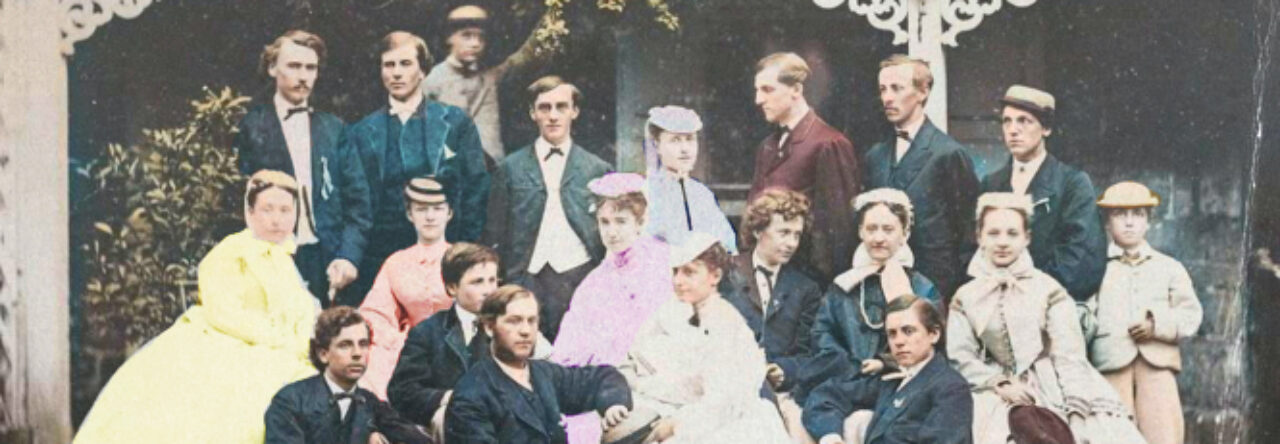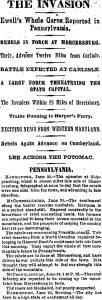After four long year of studying at Dickinson, I hope to graduate. And with this will come the long and anticipated commencement ceremony. It will be the conclusion of all my hard work here at this institution. I’m sure most students have these feelings about the ending to their college career, including the graduating class of 1863 at Dickinson. However, their commencement was far from normal. With the heart of the Civil War in place, Dickinson was caught in the middle of it. The Confederacy was advancing and gaining momentum, and were on their way from Harrisburg to Carlisle. In my previous post I researched different journals and letters from people that experienced the week long occupation and shelling of Carlisle, which was the precursor to the important Battle of Gettysburg. With so much chaos and confusion going on in Carlisle in late June through early July in 1863, it is interesting to research how people obtained the information of the events that were happening. The way we understood this event is through primary documents and newspapers. Having already investigated the first hand accounts of Carlisle residents during this time, I was eager to see what the newspaper articles were reporting on it.
To start my research, I believed that the most useful newspapers to research were local Carlisle papers. I started looking on Dickinson’s library catalog to find local newspapers. After a long and unsuccessful time researching on the databases, I came to realize that local newspapers were not online. I learned that they were only available at Dickinson’s Microfilm, located in the basement of the library. The first newspaper I attempted to research was called The Carlisle American. I was sure that there would be abundance of information of the shelling of Carlisle. After figuring out how to use the Microfilm with the help of fellow scholar Ryan Lucas, I began my research. However, it came to a dead end. Confused on why there was no reports of this event, I decided to look closer into the newspaper. I came to realize that this paper was a monthly publication, rather than a weekly. It was released on the 17th of every month. In the June issue, the invasion had not happened yet, so the articles were advertisements and general political events that were happening in the country. The next issue was on July 17th which was more Civil War specific. However, with the major event of Gettysburg happening in that time frame, most of the articles were about it and its importance. The tone of the articles were hopeful with the turning point of the war occurring. My research, however, was not. I understood that there were many newspapers to research though. I turned to another local newspaper called the American Volunteer. Before I researched the week of the bombing, I made sure this was a weekly article. Luckily, it was. This newspaper was far more informative than the  previous one. In this, it described each day and the events that had occurred. Fascinated, I read over each day, gaining more knowledge about this historic event. On one of the last days that was reported, something caught my eye. It was about the influential figure named General Smith of the Union army. During the shelling, a truce was sent over by the Confederates to General Smith. The deal was that the bombing would stop, as long as they gave up Carlisle. He refused. General Smith was known to have kept Carlisle from surrendering, and was a hero in Cumberland valley. I recalled my previous research about letters and documents from Carlisle residents recounting his war efforts.
previous one. In this, it described each day and the events that had occurred. Fascinated, I read over each day, gaining more knowledge about this historic event. On one of the last days that was reported, something caught my eye. It was about the influential figure named General Smith of the Union army. During the shelling, a truce was sent over by the Confederates to General Smith. The deal was that the bombing would stop, as long as they gave up Carlisle. He refused. General Smith was known to have kept Carlisle from surrendering, and was a hero in Cumberland valley. I recalled my previous research about letters and documents from Carlisle residents recounting his war efforts.
After finishing up my research at the Microfilm, I turned my attention to bigger publications. I referenced back to the Dickinson databases in order to gain more information. I used the PA Civil War Newspaper Collection under the Penn State library. This proved to be very useful. I simply searched “Carlisle” into the database. There were a lot of different results so I decided to narrow down my search. I filtered the time to only newspaper articles in 1863. With this I was able to acquire different newspapers that had multiple reports on the shelling of Carlisle. The first article I read was from a Philadelphia news paper named The Press on June 26, 1863. There were only brief information about Carlisle, however it was intriguing. In the subtitle it reads, “Their Advance Twelve Miles From Carlisle. Battle expected at Carlisle”. This jolted my memory of a journal entry from Charles Himes during my previous research. In his personal diary, he wrote that the rebels were 15 miles away and advancing to Carlisle. This journal entry was written on June 26, 1863. The connection between the the diary and the newspaper article was fascinating to see.
After going back to the search on the PA Civil War Newspaper Collection, I decided to research a different newspaper. I found an article from The Evening Telegraph. This  article proved to be insightful because it went into detail about the events leading up to the truce sent over by General Lee. It describes General Smith’s forces being caught by surprise by the Confederates, however was able to regain their ground and hold off the rebels. This led General Lee to send over the truce and General Smith’s heroic rejection.
article proved to be insightful because it went into detail about the events leading up to the truce sent over by General Lee. It describes General Smith’s forces being caught by surprise by the Confederates, however was able to regain their ground and hold off the rebels. This led General Lee to send over the truce and General Smith’s heroic rejection.

The Press detailing the shelling
Having read so many reports on General Smith, I focused my attention to him to see if I could find any articles on him. I went back to the PA Civil War Newspaper Collection and looked up “General Smith-Carlisle” into the search bar, along with the year 1863 to see if I could find more about this officer. An article from The Press appeared from July 3, 1863 recounting the events that had happened in Carlisle. Again, it wrote about the truce that was sent over by General Lee, and General Smith’s refusal. It also wrote about the actual bombings that occurred. It wrote “During the shelling a detachment of the enemy made a detour around the railroad and fired the barracks. the gas-works were also set on fire, the sparks from which are said to have burned several lumber yards, one private dwelling, and several barns”. This article proved that I did not know everything about the shelling, and gained more knowledge about the event. This was equally insightful as the article I found at the Microfilm, and was important to see that not just Carlisle knew about General Smith’s efforts, along with the bombings. This was read about all over the state of Pennsylvania, along with the country.
I don’t know why making the connections from first hand documents such as letters and journal, to newspapers was so interesting to me. The dates, events and people all aligned with each other, and gave a sense of validity to my research. However, I still know there is still more to explore about the Invasion of Carlisle, and I look forward to discovering it all.
Footnotes:
- “The Preservation of the Constitution” American Volunteer, June 25, 1863, Page 2, Column 1
- “The Invasion” The Press, June 25, 1863, Page 2, Column 1
- “The Situation” Evening Telegraph, July 2, 1863 Page 2, Column 1
- “The Invasion: The Battle at Carlilse” The Press, July 3, 1863, Page 1, Column 1


Leave a Reply